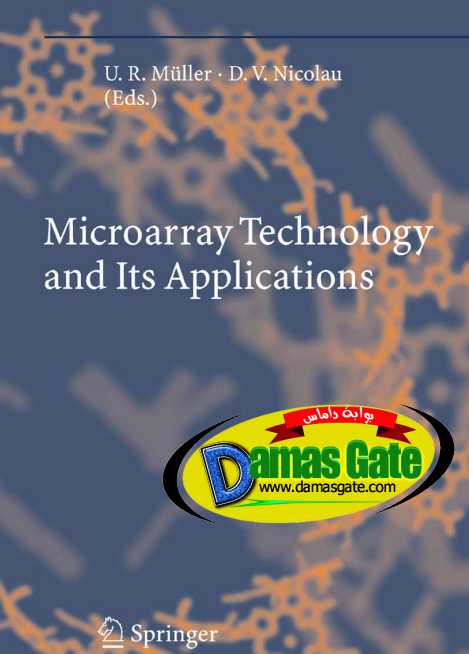Microarray Technology and Its Applications - U.R. Muller & D.V. Nicolau

Preface
It has been stated that our knowledge doubles every 20 years, but that may be
an understatement when considering the Life Sciences. A series of discoveries
and inventions have propelled our knowledge from the recognition that DNA
is the genetic material to a basic molecular understanding of ourselves and the
living world around us in less than 50 years. Crucial to this rapid progress was
the discovery of the double-helical structure of DNA, which laid the foundation
for all hybridization based technologies. The discoveries of restriction enzymes,
ligases, polymerases, combined with key innovations in DNA synthesis and
sequencing ushered in the era of biotechnology as a new science with profound
sociological and economic implications that are likely to have a dominating
influence on the development of our society during this century. Given the
process by which science builds on prior knowledge, it is perhaps unfair to
single out a few inventions and credit them with having contributed most to
this avalanche of knowledge. Yet, there are surely some that will be recognized
as having had a more profound impact than others, not just in the furthering
of our scientific knowledge, but by leveraging commercial applications that
provide a tangible return to our society.
The now famous Polymerase Chain Reaction, or PCR, is surely one of
those, as it has uniquely catalyzed molecular biology during the past 20 years,
and continues to have a significant impact on all areas that involve nucleic
acids, ranging from molecular pathology to forensics. Ten years ago microarray
technology emerged as a new and powerful tool to study nucleic acid sequences
in a highly multiplexed manner, and has since found equally exciting
and useful applications in the study of proteins, metabolites, toxins, viruses,
whole cells and even tissues. Although still relatively early in its evolution,
microarray technology has already superseded PCR technology not only in the
breadth of applications, but also in the speed with which this evolution has
taken place. Note that the literature dealing with microarrays has increased
dramatically from its humble beginnings in the mid-nineties to reach more
than 2000 articles and almost 300 reviews in 2004 alone (Fig 1). Although a
saturation point may have been reached - not surprisingly given that there is
still a limit to the number of laboratories that have access to this technologyits
impact is truly remarkable, especially when compared, for example, to the
emerging and much touted field of Nanotechnology.
Download
http://s18.alxa.net/s18/srvs2/02/003....V.Nicolau.rar

Preface
It has been stated that our knowledge doubles every 20 years, but that may be
an understatement when considering the Life Sciences. A series of discoveries
and inventions have propelled our knowledge from the recognition that DNA
is the genetic material to a basic molecular understanding of ourselves and the
living world around us in less than 50 years. Crucial to this rapid progress was
the discovery of the double-helical structure of DNA, which laid the foundation
for all hybridization based technologies. The discoveries of restriction enzymes,
ligases, polymerases, combined with key innovations in DNA synthesis and
sequencing ushered in the era of biotechnology as a new science with profound
sociological and economic implications that are likely to have a dominating
influence on the development of our society during this century. Given the
process by which science builds on prior knowledge, it is perhaps unfair to
single out a few inventions and credit them with having contributed most to
this avalanche of knowledge. Yet, there are surely some that will be recognized
as having had a more profound impact than others, not just in the furthering
of our scientific knowledge, but by leveraging commercial applications that
provide a tangible return to our society.
The now famous Polymerase Chain Reaction, or PCR, is surely one of
those, as it has uniquely catalyzed molecular biology during the past 20 years,
and continues to have a significant impact on all areas that involve nucleic
acids, ranging from molecular pathology to forensics. Ten years ago microarray
technology emerged as a new and powerful tool to study nucleic acid sequences
in a highly multiplexed manner, and has since found equally exciting
and useful applications in the study of proteins, metabolites, toxins, viruses,
whole cells and even tissues. Although still relatively early in its evolution,
microarray technology has already superseded PCR technology not only in the
breadth of applications, but also in the speed with which this evolution has
taken place. Note that the literature dealing with microarrays has increased
dramatically from its humble beginnings in the mid-nineties to reach more
than 2000 articles and almost 300 reviews in 2004 alone (Fig 1). Although a
saturation point may have been reached - not surprisingly given that there is
still a limit to the number of laboratories that have access to this technologyits
impact is truly remarkable, especially when compared, for example, to the
emerging and much touted field of Nanotechnology.
Download
http://s18.alxa.net/s18/srvs2/02/003....V.Nicolau.rar